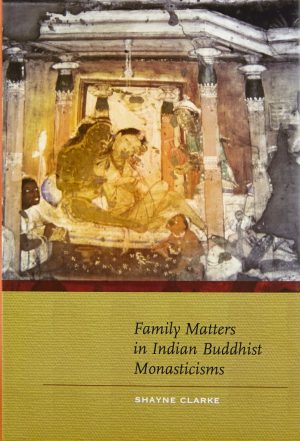Family Matters in Indian Buddhist Monacticisms
About the Book
Scholarly and popular consensus has painted a picture of Indian Buddhist monasticism in which monks and nuns severed all ties with their families when they left home for the religious life. In this view, monks and nuns remained celibate, and those who faltered in their “vows” of monastic celibacy were immediately and irrevocably expelled from the Buddhist Order. This romanticized image is based largely on the ascetic rhetoric of texts such as the Rhinoceros Horn Sutra. Through a study of Indian Buddhist law codes(vinaya), Shayne Clarke dehorns the rhinoceros, revealing that in their own legal narratives, far from renouncing familial ties, Indian Buddhist writers take for granted the fact that monks and nuns would remain in contact with their families.
The vision of the monastic life that emerges from Clarke’s close reading of monastic law codes challenges some of our most basic scholarly notions of what it meant to be a Buddhist monk or nun in India around the turn of the Common Era. Not only do we see thick narratives depicting monks and nuns continuing to interact and associate with their families, but some are described as leaving home for the religious life with their children, and some as married monastic couples. Clarke argues that renunciation with or as a family is tightly woven into the very fabric of Indian Buddhist renunciation and monasticisms.
- Author: Shayne Clarke
- Publisher: Dev Publishers & Distributors
- Edition: First
- Year: 2014
- Dimension: 16 x 23 cm
- No. of Pages: 296
- Weight: 500 gm
- ISBN: 9789381406359
- Binding: Hardcover
- Territory: South Asia
- Price: ₹ 1050
About the Author
Shayne Clarke is associate professor in the Department of Religious Studies at McMaster University.
Reviews
“Clarke’s eloquently and cogently written book should be of interest to everyone concerned with religious communities because he raises methodological issues that are pertinent to those interested in both Buddhist and non-Buddhist traditions. By employing an impressive array of sources in various languages, he gives us a carefully nuanced and fascinating study of the relationship between early Indian Buddhist monastic and familial life. Numerous translations of evidence from a variety of genres and astute analyses keep the reader riveted to his account. After reading this, my view of Buddhist monasticism will never be the same. This is clearly destined to be a classic in the field.”—Paul Groner, University of Virginia


